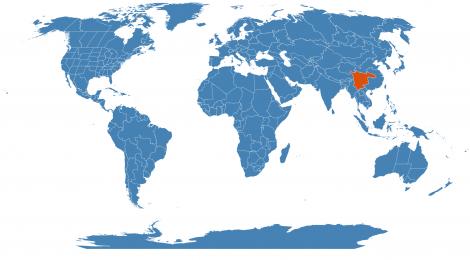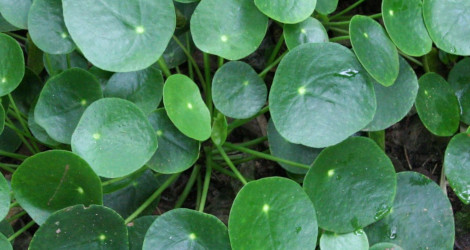Accession Data:
Pilea peperomioides Diels
- Common Name: Chinese Money Plant
- Family: Urticaceae Juss.
- Country of Origin: China (SW-Sichuan, W-Yunnan)

- Habitat: Shaded moist rocks in forests; 1500-3000 m.
- Description: Herbs perennial, rhizomatous, glabrous, often dioecious, sometimes monoecious. Stems greenish to dark brownish, often simple, erect, ascending, or climbing, 15-40 cm tall, 0.6-2 cm in diam., thick, woody at base, succulent distally, internodes 0.3-1 cm, rough; leaf scars conspicuous, semiorbicular, 3-4 mm in diam., Leaves spirally opposite, crowded on upper nodes; stipules persistent, light green, becoming brownish when dry, triangular-ovate, caudate-acuminate, squamose, 7-12 mm, with dense linear cystoliths; petiole unequal in length, 2-17 cm; leaf blade abaxially pale green, adaxially green, suborbicular, peltate, unequal in size, 2.5-9 × 2-8 cm, succulent, papery when dry, 3-veined, lateral veins 3 or 4 on each side, inconspicuous, external secondary veins numerous, anastomosing by margin, finely honeycombed abaxially, cystoliths fusiform, often conspicuous adaxially, base rounded or emarginate, margin entire, rarely inconspicuously undulate, apex rounded or obtuse. Inflorescences solitary, in upper nodes, male inflorescence a cymose panicle, 18-28 cm overall, peduncle thick, 5-14 cm; bracts lanceolate, ca. 0.5 mm; female inflorescence shorter. Male flower purplish, pedicellate, in bud obovoid, ca. 2.5 mm; calyx and corolla of a flower (generally used when the two are similar).">perianth lobes 4, obovate, connate at base, subapically corniculate; stamens 4; rudmentary ovary oblong. Female perianth lobes unequal, largest lobe cymbiform, 1/2 as long as achene. indehiscent fruit, e.g. in the genus Ranunculus">Achene purplish, broadly ovoid, ca. 0.8 mm, slightly compressed, oblique, verrucose, enclosed by persistent perianth. Fl. Apr-Jul, fr. Jul-Sep.5
- USDA Zone: 10-12
Accession Data:
- Accession # 198500364
- Source:
- Accession Date: 12-31-1985
- Bench: 1219 - AUS:South Bench E
- Currently: active - healthy
- Qty: 2 confirmed on 03-15-2025
Classification:
- Division: Magnoliophyta
- Class: Magnoliopsida
- SubClass: eurosid I
- Order: Rosales
- SubOrder:
- Family: Urticaceae
- SubFamily:
- Tribe: Lecantheae
- SubTribe:
References (internal):
- EEB Greenhouse Holdings native to: China South-Central
References (external):
- The Plant List (2013). Version 1.1. Last accessed on Thursday, 31 October, 2019.
- Pilea peperomioides at Global Biodiversity Information Facility. Last accessed on Thursday, 31 October, 2019.
- Image #00 (cropped) & #01 (original) by Michael Wolf [CC BY-SA 3.0], via Wikimedia Commons
- ARS-GRIN Taxonomy. Last accessed on Thursday, 31 October, 2019.
- Flora of China. Last accessed on Thursday, 31 October, 2019.
data regenerated on Tue, 24 Jun 2025 14:09:02 -0400 [bcm v4.0]
Images:

Additional images for this accession:
Click on thumbnails to enlargeCurrent Accessions in the Urticaceae
Subfamily
Tribe Boehmerieae
Subfamily
Tribe Cecropieae
Subfamily
Tribe Lecantheae
- Pellionia repens


- Pilea cadierei


- Pilea depressa


- Pilea nummulariifolia

- Pilea peperomioides


- Procris unidentified
Subfamily
Tribe Parietarieae
Subfamily
Tribe Urticeae
W/C = Wild Collected
 = indicates flowering in past 14 days
= indicates flowering in past 14 days
 = images available for this accession
= images available for this accession
 = map available for this accession
= map available for this accession
 = accession added within past 90 days
= accession added within past 90 days
